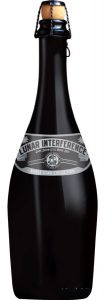 The origins of Berliner Weisse, like so many beer styles, is pretty fraught, but this tart, rather low-ABV style was once the most popular alcoholic beverage in Berlin—with around 700 breweries making it during its peak in the 19th century (per Fritz Briem’s piece in The Oxford Companion to Beer). Made with wheat in addition to barley, fermented at least partially with lactic acid bacteria, these refreshing beers were often around 3% ABV and were traditionally served with a choice of raspberry or woodruff syrups—though those are a bit challenging to find in the U.S. these days. The majority of current-day examples here are consumed on their own, though many breweries lean heavier on acidity, ABV, or employ fruit in the beer itself.
The origins of Berliner Weisse, like so many beer styles, is pretty fraught, but this tart, rather low-ABV style was once the most popular alcoholic beverage in Berlin—with around 700 breweries making it during its peak in the 19th century (per Fritz Briem’s piece in The Oxford Companion to Beer). Made with wheat in addition to barley, fermented at least partially with lactic acid bacteria, these refreshing beers were often around 3% ABV and were traditionally served with a choice of raspberry or woodruff syrups—though those are a bit challenging to find in the U.S. these days. The majority of current-day examples here are consumed on their own, though many breweries lean heavier on acidity, ABV, or employ fruit in the beer itself.
The Rare Beer Club’s highlighted a number of German-style Berliner Weisse versions over the years (in addition to this month’s Lunar Interference from August Schell), including at least a couple other releases from Schell’s Noble Star Collection, such as Basin of Attraction (a dry-hopped take) and Solar Evolution (a mashup of the Berliner Weisse style and Flanders red ale). 1809 Berliner Style Weisse (created by Dr. Fritz Briem, who also wrote the Oxford Companion’s “Berliner Weisse” entry) and The Bruery’s Hottenroth are two of the examples you’re more likely to find out in the wild, and both capture the style profile pretty well. Bear Republic’s Tartare has been solid (but heavy-handed on the acidity), and Oregon’s de Garde Brewing has spent a good bit of time here—creating a variety of intriguing fruited examples.


